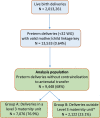Extremely and Very Preterm Deliveries in a Maternity Unit of Inappropriate Level: Analysis of Socio-Residential Factors
- PMID: 33883947
- PMCID: PMC8053703
- DOI: 10.2147/CLEP.S288046
Extremely and Very Preterm Deliveries in a Maternity Unit of Inappropriate Level: Analysis of Socio-Residential Factors
Abstract
Purpose: To analyze the socio-residential factors associated with extremely and very preterm deliveries occurring in non-level 3 maternity units in France.
Materials and methods: This is a population-based observational retrospective study using national hospital data from 2012 to 2014. A generalized estimating equations regression model was used to study the characteristics of women who delivered very preterm and the socio-residential risk factors for not delivering in a level 3 maternity unit at 24-31+6d weeks of gestation.
Results: Among deliveries resulting in live births and without contraindication to in-utero transfer, we identified 9198 extremely or very preterm deliveries; 2122 (23.1%) of these were managed in a non-level 3 unit. Our study showed that young maternal age (women under 20 years at delivery) was associated with the risk of giving birth prematurely in a non-level 3 maternity, and particularly in a level 1 maternity unit (adjusted relative risk, 1.53; 95% CI 1.09-2.16). Living more than 30 minutes away from the closest level 3 unit increased the risk of delivering very preterm in a level 1 or 2 unit. Living in an urban area or urban periphery increased the risk of giving birth in a level 2 maternity unit (adjusted relative risk, 1.53; 95% CI 1.28-1.83 and 1.42; 95% CI 1.17-1.71, respectively).
Conclusion: This study shows that young pregnant women living more than 30 minutes from a level 3 hospital have an increased risk of delivering in a maternity unit that is not equipped to deal with premature births. The risk also increases with an urban place of residence when the delivery occurs in a level 2 unit. A clearer understanding of the population at risk of delivering prematurely in a non-level 3 maternity could lead to improvements in structuring healthcare to encourage earlier management and better support.
Keywords: NICU; hospital claims data; maternity level; neonatal intensive care unit; preterm delivery; socio-residential factors.
© 2021 Roussot et al.
Conflict of interest statement
Jonathan Cottenet reports grants from IRESP during the conduct of the study. The authors declared that they have no other potential conflicts of interest for this work.
Figures
Similar articles
-
Risk factors for very preterm delivery out of a level III maternity unit: The EPIPAGE-2 cohort study.Paediatr Perinat Epidemiol. 2021 Nov;35(6):694-705. doi: 10.1111/ppe.12770. Epub 2021 May 6. Paediatr Perinat Epidemiol. 2021. PMID: 33956996
-
[Analysis of obstetric-pediatric care in the perinatal period. Are births before 31 weeks' gestation in level 2B maternity units avoidable?].Arch Pediatr. 2017 Dec;24(12):1188-1196. doi: 10.1016/j.arcped.2017.09.025. Epub 2017 Nov 17. Arch Pediatr. 2017. PMID: 29153908 French.
-
Neonatal mortality rates in communities with small maternity units compared with those having larger maternity units.BJOG. 2001 Sep;108(9):904-9. doi: 10.1111/j.1471-0528.2001.00207.x. BJOG. 2001. PMID: 11563458
-
Out-of-maternity deliveries in France: A nationwide population-based study.PLoS One. 2020 Feb 24;15(2):e0228785. doi: 10.1371/journal.pone.0228785. eCollection 2020. PLoS One. 2020. PMID: 32092074 Free PMC article.
-
Does a three-hour delayed pushing benefit the mode of delivery?J Gynecol Obstet Hum Reprod. 2023 Jun;52(6):102589. doi: 10.1016/j.jogoh.2023.102589. Epub 2023 Apr 12. J Gynecol Obstet Hum Reprod. 2023. PMID: 37059300 Review.
References
-
- Blencowe H, Cousens S, Oestergaard MZ, et al. National, regional, and worldwide estimates of preterm birth rates in the year 2010 with time trends since 1990 for selected countries: a systematic analysis and implications. Lancet Lond Engl. 2012;379(9832):2162–2172. doi:10.1016/S0140-6736(12)60820-4 - DOI - PubMed
LinkOut - more resources
Full Text Sources
Other Literature Sources



